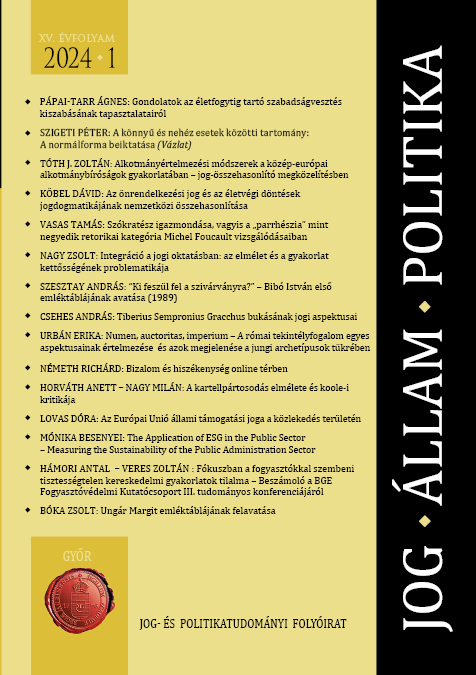Bizalom és hiszékenység online térben
ABSTRACT
The primary source of news has recently shifted from radio and television broadcasts towards social media. On online platforms, the need for reliability, and the ability to verify sources are often less prevalent or absent altogether. We are faced with an unprecedented flood of misleading and fake news that is spreading at enormous speed. It is difficult for the average educated user to cope with. In this paper, I would like to highlight the dangers we face in the digital space – especially on social media platforms – as a result of these changes, with a particular focus on the underlying causes of human frailty and the relevant national regulations.
KEYWORDS
disinformation | misinformation | fake news | legal regulations | credibility
BIBLIOGRAPHY
Allcott, Hunt – Gentkow, Matthew (2017): Social Media and Fake News in the 2016 Election. In: Journal of Economic Perspectives. 31(12).
DOI: https://doi.org/10.3386/w23089.
Bak Gerda – Kővári Edit (2019): Generációk digitális kompetencia vizsgálata: a FoMO, mint jelenség és a tudatos közösségi média alkalmazása. In: Közgazdász Fórum. 2019/22. sz.
Bányász Péter (2018): A közösségi média és közszolgálat. Nemzeti Közszolgálati Egyetem Közigazgatási Továbbképzési Intézete, Budapest. (Elérhető: http://hdl.handle.net/20.500.12944/16210. Letöltés ideje. 2023.01.27.).
Bastick, Zach (2020): Would you notice if fake news changed your behavior? An experiment on the unconscious effects of disinformation. In: European School of Political and Social Sciences. Lille Catholic University, Lille, France.
DOI: https://doi.org/10.1016/j.chb.2020.106633.
Burgin, Mark (2003): Information Theory: a Multifaceted Model of Information. In: En-
tropy: International and Interdisciplinary Journal of Entropy and Information Studies. 5(2).
DOI: http://dx.doi.org/10.3390/e5020146.
Cook, John – Ecker, Ulrich K. – Lewandowsky, Stephan (2015): Misinformation and How to Correct It. In: Scott, Robert – Kosslyn, Stephan (eds.): Emerging Trends in the Social and Behavioral Sciences. Wiley & Sons, Hoboken, New Jersey.
Digitális Fogalomtár – Modern vállalkozások programja: IKT / Információs és kommunikációs technológiák. (Elérhető: https://digitalisfogalomtar.vallalkozzdigitalisan.hu/ikt-informacios-es-kommunikacios-technologiak. Letöltés ideje: 2024.01.20.).
Erdős, Ferenc – Kallós, Gábor (2017): Economic Aspects of 3D virtual collaboration. In: Institute of Electrical and Electronics Engineers IEEE. 8th IEEE International Conference on Cognitive Infocommunications: CogInfoCom. (2017). Piscataway (NJ), USA.
DOI: https://doi.org/10.1109/CogInfoCom.2017.8268266.
Gosztonyi Gergely (2021): Az internet az új feudalizmus. In: Jogtörténet. Az MA–ELTE Jogtörténeti Kutatócsoport (ELKH) blogja. 2021. október 18.
Gosztonyi Gergely (2022a): A kínai internetcenzúra modellje. In: Pro Futuro – A jövő nemzedékek joga. 12(1).
Gosztonyi, Gergely (2022b): Aspects of the History of Internet Regulation from Web 1.0 to Web 2.0. In: Journal of European History of Law. 13(1).
Gosztonyi Gergely (2022c): Cenzúra Arisztotelésztől a Facebookig. A közösségi média tartalomszabályozási gyakorlatának komplexitása. Gondolat Kiadó, Budapest.
Ibrahim, Menna – Helmy, Yehia M. – Elzanfaly, Doaa (2021): Data quality dimensions, metrics, and improvement techniques. In: Future Computing and Informatics Journal. Vol. 6/2021.
DOI: http://dx.doi.org/10.54623/fue.fcij.6.1.3.
ITBusiness.hu, 2023. (Elérhető: https://itbusiness.hu/technology/aktualis-lapszam/itexec/a-tokeletes-deepfake-az-informatikai-es-a-cegvezetokre-is-veszelyt-jelent/. Letöltés ideje: 2024.01.27.).
Kelemen Roland (2021): Radikalizálás, dezinformálás és tömegpszichózis modern köntösben: a hibrid konfliktus kibertérben. In: Jog–Állam–Politika. 2021/3. sz.
Kelemen Roland (2022): Cyberfare State – Egy hibrid állammodell 21. századi születése. In: Miliary and Intelligence CyberSecurity Research Paper. 2022/1. sz.
Koltay András (2019): A social media platformok jogi státusa a szólásszabadság nézőpontjából. In: In Medias Res. 2019/1. sz.
Kormany.hu: A Digitális Szabadság Bizottság „Fehér Könyve”. (Elérhető: https://digitalisszabadsag.kormany.hu/feher-konyv. Letöltés ideje: 2024.02.09.).
Kuem, Jungwon – Ray, Soumya – Kim, Sung S.: What Leads to Prosocial Behaviors on Social Networking Services: A Tripartite Model. In: Journal of Management Information Systems. Vol. 34/2017.
DOI: https://doi.org/10.1080/07421222.2017.1296744.
Liew, Anthony (2007): Understanding Data, Information, Knowledge And Their Inter-Relationships. In: Journal of Knowledge Management Practice. Vol. 7/2007.
Mezei Kitti – Szentgáli-Tóth Boldizsár (2022): Az online platformok használatában rejlő veszélyek: a dezinformáció és a kibertámadások jogi kockázatai. In: Török Bernát – Ződi Zsolt (szerk.): Az internetes platformok kora. Ludovika Egyetemi Kiadó, Budapest.
Németh Richárd (2021): A COVID-19 járvány okán bevezetett home office munkavégzés hatása a munkakörülményekre és szervezeti kommunikációra nagyvállalati környezetben. In: Jog–Állam–Politika. 2021/4. sz.
Nemzeti Média- és Hírközlési Hatóság: Élesedik az álhírek elleni küzdelem: mi sem maradhatunk ki belőle, 2022. (Elérhető: https://nmhh.hu/cikk/229831/Elesedik_az_alhirek_elleni_kuzdelem_mi_sem_maradhatunk_ki_belole. Letöltés ideje. 2024.01.27.).
Nielsen, Susanne (2012): Persuing Security in Cyberspace. Foreign Policy Research Institute, Philadelphia, USA.
Nyilasy, Greg (2020): Fake News in the Age of COVID-19. University of Melbourne, Faculty of Business and Economics, Australia.
Oversightboard.com – A Facebook tartalomra vonatkozó szabályzatának értékei. (Elérhető: https://oversightboard.com/meet-the-board/. Letöltés ideje: 2024.02.09.).
Papp János Tamás (2020): A hamis hírek alkotmányos helyzete és szerepe a demokratikus nyilvánosság befolyásolásában. In: In Medias Res. 2020/1. sz.
Schmidhuber, Jürgen (2015): Deep learning in neural networks: An overview. In: Neural Networks. Vol. 61/2015.
DOI: https://doi.org/10.1016%2Fj.neunet.2014.09.003.
Smuk Péter (2023): Demokratikus legitimáció - Alkotmánytani értekezések a cserépszavazástól a mesterséges intelligenciáig. Universitas-Győr Nonprofit Kft., Győr.
Synergia Foundation: World wide web inventor targets fake news, 2017. (Elérhető: https://www.synergiafoundation.org/insights/analyses-assessments/world-wide-web-inventor-targets-fake-news. Letöltés ideje. 2024.01.29.).
University of Michigan Library: „Fake News”, Lies and Propaganda: How to Sort Fact from Fiction. (Elérhető: https://guides.lib.umich.edu/fakenews. Letöltés ideje. 2024.01.29.).
Velleman, Paul F. – Wilkinson, Leland (1993): Nominal, Ordinal, Interval, and Ratio Typologies Are Misleading. In: The American Statistician. Vol. 47/1993.
DOI: 10.1080/00031305.1993.10475938.
Walters, Ryan M. (2018): How to Tell a Fake: Fighting Back Against Fake News on the Front Lines of Social Media. In: Texas Review of Law & Politics. Vol. 111/2018.
World Economic Forum: These are the 3 biggest emerging risks the world is facing, 2024. (Elérhető: https://www.weforum.org/agenda/2024/01/ai-disinformation-global-risks/. Letöltés ideje: 2023.01.29.).
Ződi Zsolt (2023): Platformjog - Elméletek és hatályos szabályok. Ludovika Egyetemi Kiadó, Budapest.
legal references
1163/2020. (IV. 21.) Korm. határozat Magyarország Nemzeti Biztonsági Stratégiájáról.
487/2020. (XI.11.) Korm. rendelet a veszélyhelyzet során a távmunkával kapcsolatos szabályok alkalmazásáról.
Európai megközelítés az online félretájékoztatás kezelésére. COM(2018) 236 final, Brüsszel, 2018. április 26. 1–2.
European Commission (2018): Report of the Independent High level Group on fake news and online disinformation. A multidimensional approach to disinformation. Pubications Office of the European Union, Luxembourg.

